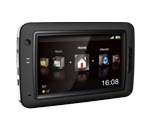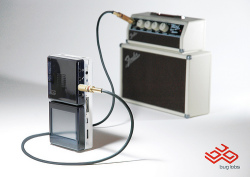Open Source at CES 2009

The Movit Mini
Open source is not something routinely thought of in connection with consumer electronics. Any visible open source at the CES show in Las Vegas last week was hard to find, so hard some people, like LXer's Scott Ruecker nearly gave up. All he could find were EEE PC's running Windows XP, not Linux and a Dell laptop running Ubuntu. The Dell laptop doesn't really count since Dell weren't exhibitors at CES.
Androids advance
What was at CES though, were some interesting devices that are using Android, Google's open sourced mobile operating system. Engadget reports that GiiNii were showing the GiiNii Movit Wifi, which apparently runs Android. The Movit has a 4.3 inch resistive touch screen, with a soft keyboard for text entry. It seems aimed at the iPod Touch market, but sports only 256MB of internal storage, the rest being provided by whatever is plugged into the microSD expansion slot. A front facing camera, a built in microphone and Skype support are some features it has that the iPod Touch doesn't. Engadget report that it is due to be available in the middle of the year and that there's also going to be a 7 inch screen version.
Meanwhile CrunchGear reported on the Touch Revolution's NIMble, another Android powered device, this time a desktop phone design with a lot of extra intelligence. Unlike the Movit, the Touch Revolution NIMble has what it calls "Glass Surface Projective Capacitive Touch Screen" with low finger resistance. The Android Guys blog has more detailed specifications for the NIMble. The expected release date is September and it will be priced at around $300.
In a sign that Android may be eating into other mobile phone Linux implementations, Slashgear noted that Wistron NeWeb's GW4 Linux phone, which was on show and already running a mobile Linux, will be getting an update to Android later on in the year. The GW4 is a smartphone with a 2.5 inch QVGA screen, keyboard, Wifi, Bluetooth and a 2 megapixel camera. The Android Guys also found Qualcomm at CES, showing their new SnapDragon chipset for mobile devices and Qualcomm are recommending Android as the operating system to run with the chipset. A number of Open Handset Alliance (OHA) members already have devices based around the chipset, including Wind River, who produced code to get Android running on the WVGA resolution screen of the SnapDragon demonstration.
Buglabs expansion

The BUGsound Module from Bug Labs
Bug Labs were at CES showing the latest modules in their BUGModules range. Bug Labs make a range of plug together devices that attach to the BUGBase, an ARM based processor with 128MB of memory, MPEG4 encoder / decoder and various interfaces. Current modules include a GPS receiver, accelerometer, touch screen and camera. All the modules and the Linux based operation system are open source and the entire system allows for rapid prototyping of new types of devices. At CES, Bug Labs launched five new modules including the BUGprojector, a mini-DLP projector developed in conjunction with Texas Instruments. The BUGsound module adds a 20mm speaker, omni-directional microphone, sound jacks for audio input and output, headphones and an external microphone. For wireless connectivity, Bug Labs have BUGWifi for IEEE802.11 Wifi and bluetooth support and BUGbee, which supports IEEE802.15.4, also known as ZigBee, for low power, low speed connections. The last module is the BUG3g GSM module, which will allow Bug based devices to phone home over 3G phone networks.
(djwm)
![Kernel Log: Coming in 3.10 (Part 3) [--] Infrastructure](/imgs/43/1/0/4/2/6/7/2/comingin310_4_kicker-4977194bfb0de0d7.png)

![Kernel Log: Coming in 3.10 (Part 3) [--] Infrastructure](/imgs/43/1/0/4/2/3/2/3/comingin310_3_kicker-151cd7b9e9660f05.png)
















